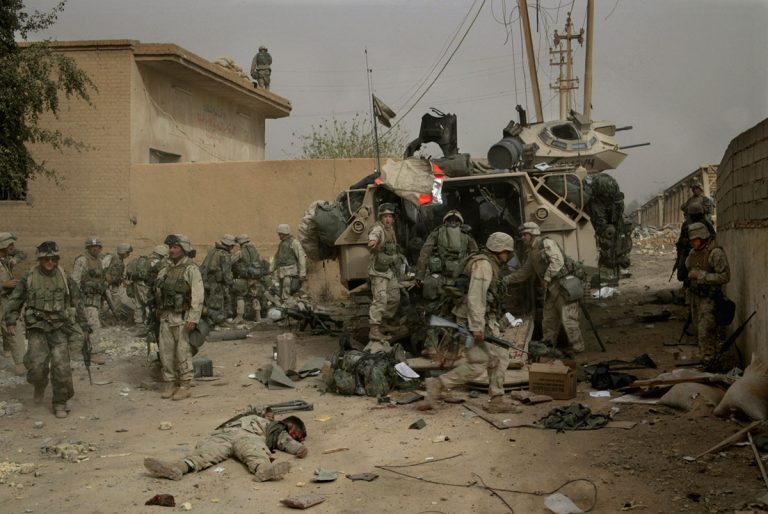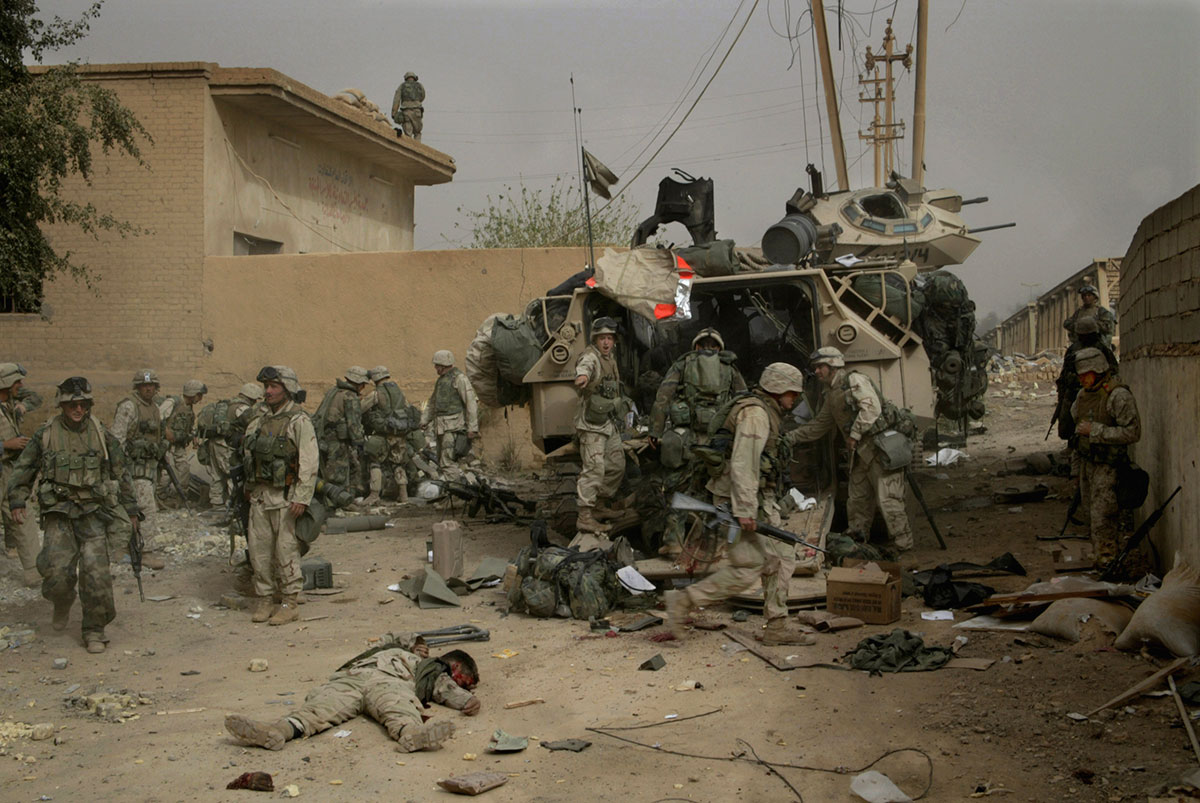Susan Sontag’s book Regarding the Pain of Others concludes with a discussion of Jeff Wall’s huge photograph ‘Dead Troops Talk (A Vision after an Ambush of a Red Army Patrol, near Moqor, Afghanistan, Winter, 1986)’. ‘Exemplary in its thoughtfulness and power’, this image of a ‘made-up event’ was constructed in Wall’s studio. ‘The antithesis of a document’, the picture’s effectiveness derives, in other words, from the fact that it is a fiction.
But what effect does this have, in turn, on combat photographs that are documents? Are they diminished or enhanced by comparison with Wall’s mock-up?
Consider, for example, Peter van Agtmael’s well-known photograph of a line of US troops sheltering from the downdraft of a helicopter in a rocky grey landscape in Nuristan, Afghanistan, in 2007.
Its compositional resemblance to Wall’s image suggests that the fictive can set a standard of artistic authenticity to which the real is obliged to aspire – and can still, accidentally, achieve. At the same time, its similarity to W. Eugene Smith’s shot of Marines sheltering from an explosion on Iwo Jima in 1945 testifies to its place in the heroic tradition of documentary photography.
It reminds us, also, that George Bernard Shaw’s appeal to photographic proof still holds good, in a battered and shop-worn (as opposed to photo-shopped) sort of way, despite the challenge of digital. Shaw said that he would willingly exchange every painting of the crucified Christ for a single snapshot of Him on the cross. ‘That,’ as Magnum photographer Philip Jones Griffiths insisted, ‘is what photography has got going for it.’
Or is this to miss an important point about Wall’s work, namely its relationship not to photography as traditionally conceived – as a kind of visual stenography – but to the imaginative ambition and reach of history painting? Sontag herself describes Wall’s intentions as ‘the imagining of war’s horrors (he cites Goya as an inspiration), as in nineteenth-century history painting and other forms of history-as-spectacle.’
If van Agtmael’s photograph falls short of the epic scale of this ambition then we can turn to a picture taken by Gary Knight in Iraq in April, 2003. The photograph is actually part of a sequence recording the battle for Diyala Bridge. All of the pictures have the kind of immediacy we associate with photojournalism from Capa and Smith in the Second World War, to Larry Burrows and Don McCullin in Vietnam. Taken together they make up a visual narrative of combat and its aftermath with which we have become wrenchingly familiar. At its heart, however, is a single photograph that contains the larger story of which it is part.
Knight himself has provided a vivid account of the terrifying context in which the picture was made: ‘This was at the start of the invasion. We were at the Diyala Bridge, which had to be taken by the marines so they could get into Baghdad. They were the lead battalion, the ones who went on to pull down the statue of Saddam. The opposition were shelling us. It was terrifying – both the actual shelling, and the anticipation of it. It comes in waves so you can see it moving in your direction. One had exploded in the tank. If it had landed on top or a couple of feet over, I would have died.’
In the dead centre of the picture a soldier is pointing – directing our attention – to the corpse that everyone else, with the possible exception of the soldier advancing towards the camera on the extreme left, seems determined to ignore. Understandably: in situational terms he is the least important figure there; in every other way, he is the most important figure in the picture, its unavoidable focus.
The dead man is also the epicentre of the remarkable stillness of the picture, a stillness that emanates from and converges on him. (The slight blurring of the leg and foot of the soldier walking across the scene shows that a relatively slow shutter speed was enough to capture everyone else with near-perfect clarity.) There is a lot of activity – a lot going on and a lot to be done – but there is almost no movement. There is thus a kind of double stillness: the stunned stillness that comes after a battle and the stillness of oil painting, a stillness that does not stop time (as happens in fast-shutter-speed photography) but contains it. Oil paintings imaginatively recreate the swirl of action and battle with the steadiness of observation the painter would bring to bear on a still life (a bowl of fruit, say, or flowers). Photography can record actual combat but only with the kind of urgency and blur of Capa’s famous picture of a Republican soldier being killed in the Spanish Civil War or – – for disputed reasons – – his shots of the D-Day landings. Only in the aftermath of extreme violence can the twin strengths of photograph and oil painting be combined in this single extended moment.
It is not at all unusual for news photographs to echo the paintings of the past, either deliberately or accidentally. In 1967 John Berger famously pointed out the similarities between the photograph of the corpse of Che Guevara and Rembrandt’s painting of The Anatomy Lesson of Professor Tulip. A year later James Louw photographed Martin Luther King’s friends and associates on the balcony of the Lorraine Motel in Memphis, after he had been shot.
It’s a picture of instantaneous journalistic and historic importance but the way three arms are raised, pointing in the direction of the presumed assassin — not, as in Knight’s Diyala Bridge picture, at the victim — mirrors the three brothers in Jacques-Louis David’s Oath of the Horatii (1784).
This, surely, was not in Louw’s mind at the time he took the picture. The parallels, however, are not merely visual. As art historian Hugh Honour writes in Neo-Classicism, David chose to depict ‘a moment not mentioned by any historian… in which the highest Roman virtues were crystallized in their finest and purest form. This was the moment of the oath when the three youths selflessly resolved to sacrifice their lives for their country.’ Or, as King had put it in a speech the night before his assassination, ‘Like anybody, I would like to live a long life. Longevity has its place. But I’m not concerned about that now. I just want to do God’s will.’
While the Louw picture instantly recalls David’s, Knight’s suggests a generalised memory of several paintings without quite superimposing itself on any one in particular. (The overall colour of the picture – a sandy, dusty, light brown that extends to and dulls the glow of the sky – is like the default hue of any numbers of paintings of atrocities, battles and assorted barbarisms in the middle-east: the Orient, as Delacroix and his contemporaries conceived it).
The centre foreground of Napoleon on the Battlefield of Eylau (1808) by David’s pupil Antoine-Jean Gros is dominated by a heap of corpses, around which the rest of the figures are arranged, but the fit is far from exact. Paintings of various scenes and battles from the American Civil War – Charles Prosper Sainton’s Pickett’s Charge, Battle of Gettysburg (1863), say – provide only rough templates. Knight’s Diyala Bridge photograph quotes from an actual event but not from an identifiable painting. It combines the documentary immediacy and evidential power of the best photojournalism with the epic grandeur of history painting.

